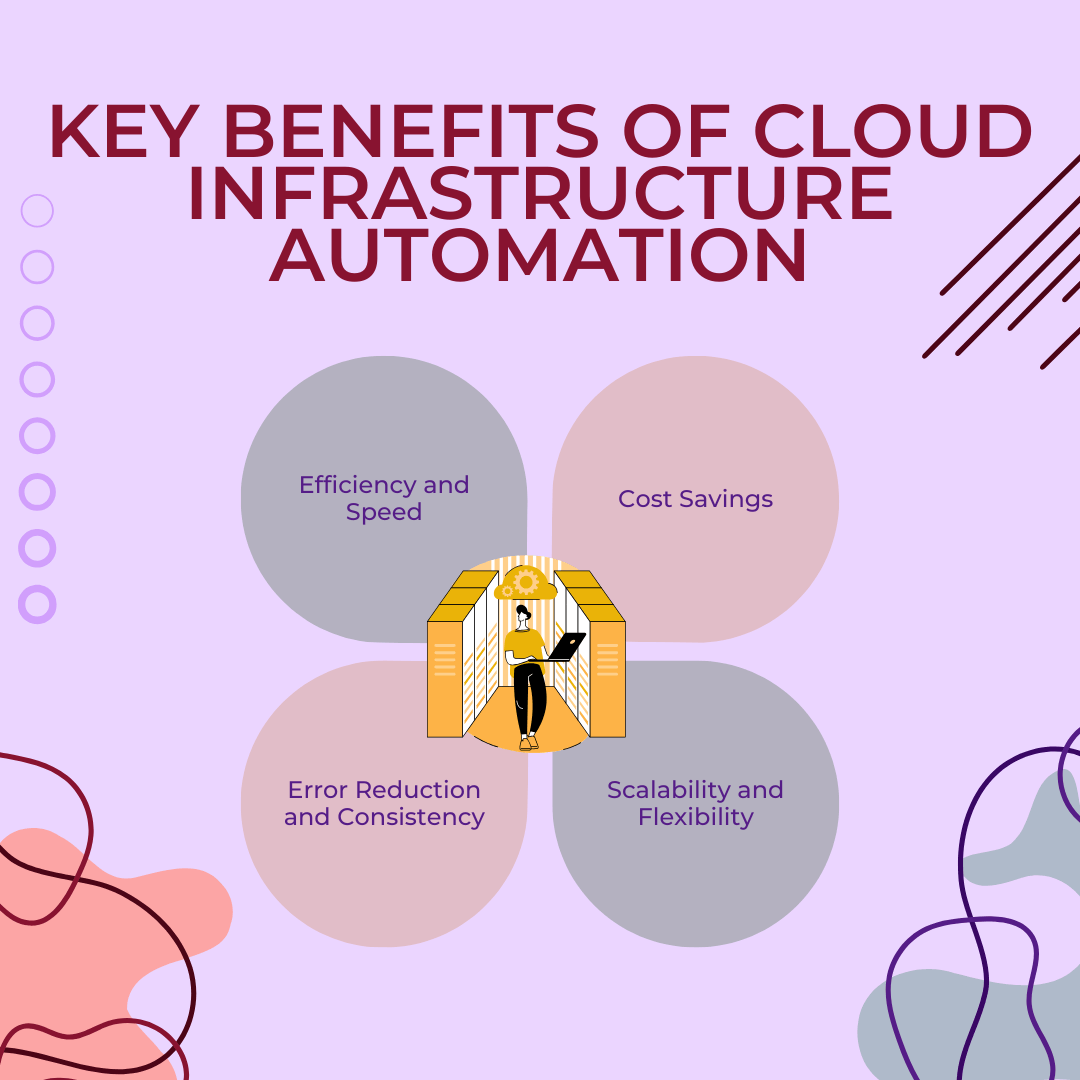Introduction
Manual management of cloud infrastructure can result in inefficiencies, mistakes, and higher expenses. These challenges become more pronounced as organizations scale their operations. Cloud infrastructure automation offers a compelling solution by streamlining resource management, reducing human error, and optimizing costs.
Embracing automation not only addresses these pressing issues but also enhances scalability and operational efficiency, positioning businesses for long-term success in a dynamic tech landscape.
Understanding Cloud Infrastructure Automation
Cloud infrastructure automation is a pivotal concept in modern IT management, enabling organizations to efficiently manage their cloud resources with minimal manual intervention. At its essence, it uses software tools and methods to automate the deployment, configuration, and management of cloud infrastructure.
Infrastructure as Code (IaC) is a foundational element of cloud infrastructure automation. IaC allows for the creation and management of cloud resources through code, rather than manual processes.
This method guarantees consistent, repeatable infrastructure configurations that can be easily managed and version-controlled. Popular IaC tools like Terraform and AWS CloudFormation simplify the creation and management of cloud environments by translating infrastructure requirements into code.
Configuration management is another critical component, focusing on maintaining the desired state of infrastructure and applications. Tools such as Ansible, Puppet, and Chef automate the configuration and management of servers and applications, ensuring they remain in the intended state without manual intervention. This reduces the risk of configuration drift and operational errors.
Orchestration involves coordinating multiple automated tasks to ensure they work together seamlessly. It manages the deployment, scaling, and networking of applications across cloud environments.
Kubernetes and Docker Swarm are prominent orchestration tools that help in automating the deployment and scaling of containerized applications, thus facilitating efficient resource management.
Core Components of Cloud Infrastructure Automation
Cloud infrastructure automation is built on several key components, each playing a vital role in simplifying and optimizing cloud management processes.
Infrastructure as Code (IaC) is central to automation, allowing organizations to define and manage cloud resources through code rather than manual processes. IaC tools, such as Terraform and AWS CloudFormation, enable users to script their infrastructure needs, making deployments repeatable, predictable, and less prone to human error.
By codifying infrastructure, teams can version-control configurations and rapidly deploy consistent environments across different stages of development.
Configuration Management ensures that servers and applications are maintained in their desired state. Tools like Ansible, Puppet, and Chef automate the configuration of systems and applications, allowing for standardized setups across large-scale environments.
This automation not only streamlines operations but also mitigates the risk of configuration drift and operational inconsistencies, ensuring that all systems adhere to the same configuration standards.
Orchestration coordinates multiple automated tasks to ensure seamless integration and operation across various components. It handles the deployment, scaling, and management of applications within a cloud environment.
Prominent orchestration tools, such as Kubernetes and Docker Swarm, manage containerized applications, handling their deployment, scaling, and networking. This coordination is crucial for optimizing resource usage and maintaining high availability.
Key Benefits of Cloud Infrastructure Automation
Cloud infrastructure automation provides game-changing advantages, greatly improving the efficiency and productivity of cloud operations.
Efficiency and Speed are among the most immediate advantages. Automation speeds up the deployment and scaling of cloud resources, cutting down the time needed to launch new services.
For instance, a technology company reduced its deployment time by 50% after adopting automation, streamlining operations and accelerating time-to-market for new features. This efficiency not only speeds up processes but also enhances overall productivity.
Cost Savings are another critical benefit. By minimizing manual intervention, automation reduces the need for extensive human resources, cutting down on labor costs. Automated systems also optimize resource allocation, preventing over-provisioning and under-utilization.
For example, a cloud-based enterprise observed a 30% reduction in operational costs after implementing automation, thanks to more efficient resource management and reduced manual oversight.
Error Reduction and Consistency are enhanced through automation. Manual processes are prone to human errors, which can lead to configuration inconsistencies and operational disruptions.
Automation guarantees consistent and repeatable configurations, minimizing the risk of errors. A large-scale deployment benefited from automation by achieving improved accuracy and fewer operational issues, highlighting the reliability and consistency that automation provides.
Scalability and Flexibility are crucial for adapting to changing demands. Automation enables seamless scaling of resources to handle increased loads without manual intervention. This capability is essential for businesses that experience variable workloads.
For instance, during peak periods, automation allowed a company to effortlessly scale its infrastructure to meet increased demand, showcasing its ability to adapt and manage growth efficiently.

Implementing Cloud Infrastructure Automation
Successfully implementing cloud infrastructure automation involves a series of strategic steps to ensure a smooth transition and optimal outcomes.
Assessing Needs and Goals is the first crucial step. Begin by evaluating your current infrastructure and identifying specific needs and objectives. This assessment helps in understanding which aspects of your infrastructure will benefit most from automation and setting clear goals for what you aim to achieve, whether it’s reducing deployment times, cutting costs, or improving scalability.
The next step is selecting the right tools. Choose automation tools that match your requirements and objectives, keeping in mind factors like integration simplicity, scalability, and compatibility with your cloud environment.
Tools like Terraform and AWS CloudFormation for Infrastructure as Code, Ansible and Puppet for configuration management, and Kubernetes or Docker Swarm for orchestration are popular choices. Each tool offers distinct features and advantages, so choose based on your specific requirements.
Best Practices for Successful Implementation are key to achieving effective automation. Start with a well-defined strategy, including thorough planning and a clear implementation roadmap. Begin with pilot projects to test automation workflows and gradually expand.
Ensure comprehensive documentation and training for your team to facilitate smooth adoption. Regular monitoring and fine-tuning are also essential to address any issues and optimize performance.
For example, a company that successfully implemented cloud infrastructure automation began by automating non-critical components and then expanded to more critical systems. This phased approach allowed them to refine their processes and achieve successful integration with minimal disruption.
Challenges and Solutions in Cloud Infrastructure Automation
Although cloud infrastructure automation provides many advantages, organizations frequently encounter challenges during its implementation. Addressing these issues effectively is crucial for a successful automation strategy.
Technical Challenges frequently arise due to the complexity of integrating automation tools with existing systems. Compatibility issues between different tools and technologies can hinder smooth operation.
To overcome this, organizations should conduct thorough assessments of their current infrastructure and carefully select automation tools that align with their needs. Leveraging well-documented and widely-supported tools can help mitigate integration issues.
Organizational Challenges often include resistance to change and a lack of skilled personnel. Teams may be hesitant to adopt new technologies, and finding qualified staff with the right expertise can be difficult.
To address these challenges, it’s essential to foster a culture that embraces technological advancements. Providing training and development opportunities for existing staff and considering external consultants can help bridge the skills gap.
Security Challenges are also a concern, as automating infrastructure can introduce new vulnerabilities if not managed properly. It is essential to ensure that automation scripts and tools follow security best practices.
Implementing robust access controls, regularly reviewing and updating security configurations, and conducting security audits can help safeguard against potential threats.
Strategies to Overcome These Challenges include adopting a phased implementation approach, starting with less critical systems to build confidence and experience.
Regular testing and iterative improvements can address technical and security issues as they arise. Engaging stakeholders early and often can also facilitate smoother transitions and better alignment with organizational goals.
Future Trends in Cloud Infrastructure Automation
As cloud infrastructure automation continues to evolve, several key trends are shaping its future and expanding its potential.
Emerging Technologies are driving innovation in automation. Artificial Intelligence (AI) and machine learning (ML) are increasingly being integrated into automation tools, enabling more intelligent and adaptive systems.
These technologies have the ability to forecast infrastructure requirements, optimize resource distribution, and improve decision-making processes. For example, AI-driven automation can analyze usage patterns to automatically adjust resource levels, improving efficiency and reducing costs.
Predictions for the Next 5-10 Years suggest that automation will become even more sophisticated and integral to cloud operations. Advances in AI and ML are expected to lead to more autonomous systems capable of handling complex tasks with minimal human intervention.
Additionally, the rise of serverless computing and edge computing will influence automation strategies, as organizations seek to manage increasingly distributed and dynamic environments.
Industry Impact will be profound, with automation transforming various sectors by enhancing operational efficiency and agility. Industries such as finance, healthcare, and retail will benefit from automation's ability to streamline processes, improve scalability, and drive innovation.
For instance, automation in the healthcare sector could lead to more efficient data management and patient care, while retail could see enhanced inventory management and customer experience.
Key Takeaways
- Cloud Infrastructure Automation Streamlines Management: Automation simplifies cloud resource deployment and management, enhancing efficiency and scalability.
- Core Components Include IaC, Configuration Management, and Orchestration: Tools like Terraform, Ansible, and Kubernetes are essential for automating infrastructure, configurations, and application orchestration.
- Benefits Include Cost Savings and Error Reduction: Automation reduces manual labor costs, minimizes errors, and ensures consistent infrastructure configurations.
- Implementation Challenges Involve Technical and Security Issues: Overcome integration, resistance to change, and security concerns with careful planning and best practices.
- Future Trends Feature AI Integration and Enhanced Automation: Emerging technologies will drive more intelligent and autonomous systems, impacting various industries with improved efficiency and scalability.
Conclusion
Cloud infrastructure automation revolutionizes IT operations by enhancing efficiency, reducing costs, and scaling resources effectively. Key components like Infrastructure as Code (IaC), configuration management, and orchestration, work together to streamline deployment and management processes.
While implementation presents challenges such as technical integration and security concerns, addressing these with strategic planning and best practices is crucial. Future advancements, particularly in AI and machine learning, will further refine automation, making systems more intelligent and adaptive.
Overall, embracing cloud infrastructure automation is essential for optimizing operations and staying competitive in a rapidly evolving tech landscape.

